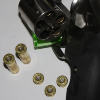jfh
Member.
Here's a picture of 38 Special case head separations:

OK, now that I know I got the image up OK, I'll add the comments.
1. These were NEW Starline 38 Special cases.
2. The recipe was from Speer, for AA#7 with the Speer GDSB 135-gr. bullet.
3. A reloading error was made (not double-charging) resulting in an overpressure load.
4. All 5 rounds were fired--and they were B-I-G rounds--but I've fired bigger (in a bigger 357)
5. The revolver still functioned--but: when the gunsmith looked it over, he found stretching on each chamber.
A reloader in another forum worked up the pressure from this load--ostensibly, about 17-18 gr. of #7--and calculated the pressure was at least 55,000, and maybe 72,000.
Look closely at those primers: seen any that look similar? That look similar in a 357 Magnum Round? I have...
Now, compare those primers to ones from a 38 Special recipe that runs 17,000, or 18,500. Can you accurately 'scale' the deformations?
added on edit: I went back and reviewed the latest comments. I'll refrain from commenting on 38 / 357 brass differences, as I have done no real surveying of it. But, Bob's latest comment about manufacturing specs is worth amplifying. As he points out, we are dealing with what appear to be 'reasonable' assumptions about how manufacturers specify their brass and how they use it. There certainly is nothing to prevent them from using 357-spec sheet goods to stamp out 38 special cases--but there's nothing requiring them too, either. In sum, when we make assumptions about case and primer deformations, we operate on a paradigm often changed / modified by any party in the process. It ain't SAAMI (or whoever) certified. The point is NOT that official specifications are "better," the point is that any time we step outside that boundary, we are testing procedures--and those tests are not generally quantifiable by us out here in the field.
Jim H.

OK, now that I know I got the image up OK, I'll add the comments.
1. These were NEW Starline 38 Special cases.
2. The recipe was from Speer, for AA#7 with the Speer GDSB 135-gr. bullet.
3. A reloading error was made (not double-charging) resulting in an overpressure load.
4. All 5 rounds were fired--and they were B-I-G rounds--but I've fired bigger (in a bigger 357)
5. The revolver still functioned--but: when the gunsmith looked it over, he found stretching on each chamber.
A reloader in another forum worked up the pressure from this load--ostensibly, about 17-18 gr. of #7--and calculated the pressure was at least 55,000, and maybe 72,000.
Look closely at those primers: seen any that look similar? That look similar in a 357 Magnum Round? I have...
Now, compare those primers to ones from a 38 Special recipe that runs 17,000, or 18,500. Can you accurately 'scale' the deformations?
added on edit: I went back and reviewed the latest comments. I'll refrain from commenting on 38 / 357 brass differences, as I have done no real surveying of it. But, Bob's latest comment about manufacturing specs is worth amplifying. As he points out, we are dealing with what appear to be 'reasonable' assumptions about how manufacturers specify their brass and how they use it. There certainly is nothing to prevent them from using 357-spec sheet goods to stamp out 38 special cases--but there's nothing requiring them too, either. In sum, when we make assumptions about case and primer deformations, we operate on a paradigm often changed / modified by any party in the process. It ain't SAAMI (or whoever) certified. The point is NOT that official specifications are "better," the point is that any time we step outside that boundary, we are testing procedures--and those tests are not generally quantifiable by us out here in the field.
Jim H.
Last edited:



